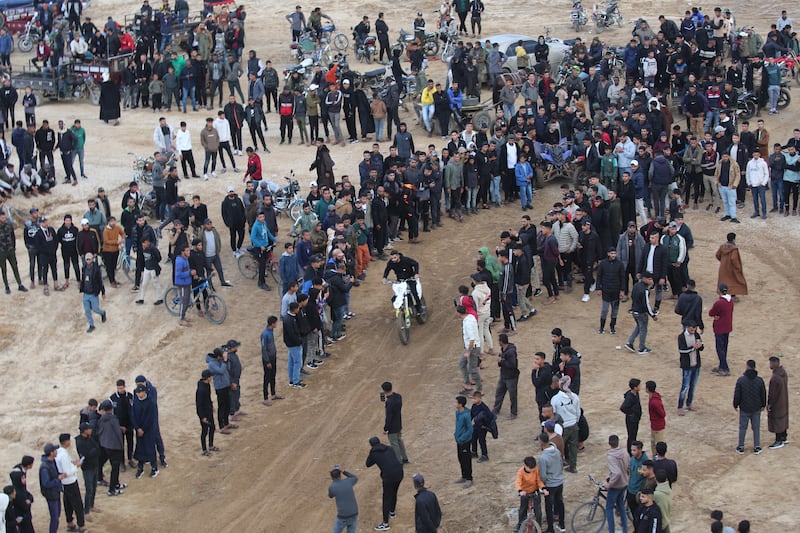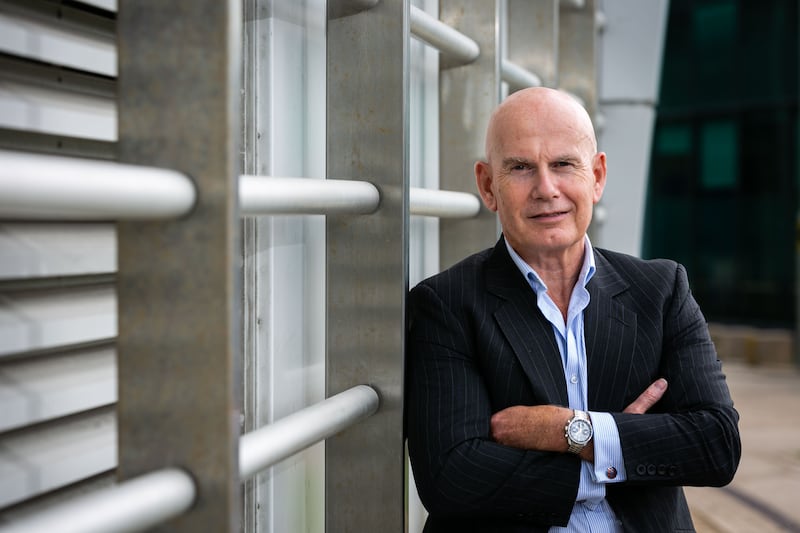Last Sunday, Mike Connell, a former Defence Forces corporal turned far-right activist, posted a crude cartoon to his YouTube channel depicting him shooting a teacher in the head.
Later in the video, which Connell claimed was “satire”, Minister for Justice Helen McEntee is depicted being killed by a lightning strike in revenge for her attempts to introduce hate speech legislation.
Four days on, the former soldier was one of a who’s who of prominent far-right activists who gathered outside Leinster House on the first day of the new Dáil term.
The turnout – roughly 200 – was not substantial, even by the metrics of Ireland’s small far-right movement. What set it apart was the level of anger on display and the implicit and explicit threats of violence directed at politicians and Leinster House staff by some demonstrators. A mock gallows, covered in portraits of prominent politicians, was erected in front of the building, and TDs and staff entering and exiting were pushed, harassed and branded “traitors”.
READ MORE
In the late afternoon, some of the protesters blocked TDs from leaving the building for about two hours. In total there were 13 arrests, with more expected in the coming weeks.
The protest, dubbed Call to the Dáil by its organisers, was heavily promoted on far-right social media channels and was chiefly aimed at protesting against McEntee’s stalled hate speech bill.
[ How did the hate speech Bill find itself at the centre of a swirling culture war?Opens in new window ]
Based on the speeches and placards on display, it morphed into a protest against a wide variety of issues including, but not limited to, asylum seekers and refugees; trans rights; sex education in schools; the World Economic Forum; vaccines, including Covid-19 vaccines; globalisation; and support for Ukraine.
One woman handed out leaflets denouncing the proposed Right to Housing Bill, claiming it will grant the Government power to kick people out of their houses, and another warned of “Marxist” schoolteachers. The unifying theme was that elected politicians, including Sinn Féin TDs and independents, are “traitors” who must be removed.
Some of those in attendance are veteran activists in the anti-immigration and conspiracy theory sphere. Rowan Croft, an ex-British soldier, who came to prominence spreading the Q Anon conspiracy theory through YouTube and attempting to tie it to Irish matters, was there after a long absence from the far-right scene.
Several current and former acolytes of journalist turned conspiracy theorist Gemma O’Doherty, including close associate Peter Madden, were also there. However, O’Doherty herself, who was once at the core of the movement, was absent, having grown apart from far-right influencers in recent months.
Some of those at the demonstration came to public notice objecting to Covid-19 vaccine roll-outs. This included at least two doctors, including Dr Vincent Carroll, a vocal vaccine critic, who said he was there “to preserve this great nation” from “scoundrels”.
Others attendees came to the fore protesting immigration last year. In 2022, Malachy Steenson, a former Workers’ Party election candidate, positioned himself as the leader of the East Wall Says No movement, a protest group objecting to the housing of asylum seekers in the north Dublin area.
The group’s tactics, which included blocking traffic for long periods of time, soon spread to other parts of Dublin earmarked for asylum seeker housing.
Steenson was one of the main figures encouraging protesters to gather at the Dáil on Wednesday. In a video on Tuesday he called on people to “begin the process of taking our country back from those who wish to destroy it”.
Also present was Gavin Pepper, another anti-immigration activist who has been a leader in several recent demonstrations.
The taxi-driver, who is planning to run in next year’s local elections, attended a protest in the city centre in May that ended with a migrant camp on Sandwith Street being set alight. Pepper later said gardaí raided his house and accused him of being responsible.
There were several other figures present on Wednesday who have come to Garda attention in recent months, including Andy Heasman, who was arrested on public order charges on St Patrick’s Day after attempting to disrupt the parade in Dublin.
During the pandemic he served a short spell in prison for refusing to wear a face mask on a bus. He was also involved in an anti-vaccine protest outside the home of Taoiseach Leo Varadkar in 2021.
In recent weeks, Heasman has been travelling around Ireland with a group of men in a small boat to protest outside libraries that he claims are exposing children to inappropriate reading materials.
The demonstrations led to several libraries closing over safety concerns and several clashes with counter protesters. Heasman was joined on the journey by Ross Lahive, another participant at Wednesday’s demonstration, who has also been before the courts recently.
Last month, on the same day as a protest against a library in Cork City, Lahive was arrested on suspicion of knife possession. He was later arrested again for failing to appear at a court hearing.
Representatives from the main far-right political groups were also in attendance on Wednesday, including Derek Blighe who registered the anti-immigration party Ireland First earlier this year.
The party intends to contest the local, national and European elections as a “centre-right nationalist party”. Blighe first came to prominence for stealing clothes from a Ukrainian support service in Cork last year, prompting gardaí to seize his legally held firearms.
He has since become one of the country’s most active anti-immigrant protesters. In his address to the crowd on Wednesday, he claimed there were undercover gardaí among them attempting to instigate trouble.
Shane Lynam, the vice-chair of the Irish Freedom Party, also attended and spoke about co-operation with Blighe’s Ireland First party. Although members of the rival National Party were in attendance, its two main figures, Justin Barrett and James Reynolds, were absent. The party recently split amid controversy over the ownership of gold bars.
None of these protesters were among those arrested or who directed violence and threats against TDs and members of the public on Wednesday. On far-right social media channels the next day, some claimed, without evidence, that those involved in the violence were Garda plants.
The nature of Wednesday’s protests shocked many politicians but there was little surprise among veteran observers of the far right.
[ How to combat the far right in your neighbourhood. Step 1: Don’t counter-protestOpens in new window ]
“In recent months we have seen YouTube host videos depicting sitting ministers being shot in the head and Facebook carry live-streams of library workers being falsely accused of child abuse,” said a spokesman for the Hope and Courage Collective, an organisation that monitors the Irish far right. “The scenes on Kildare street yesterday should serve as a red flag to those inside both houses.”
The collective criticised social media companies for facilitating the spread of hateful and violent rhetoric. It also criticised certain politicians who condemned Wednesday’s demonstration after being happy in the past to champion some of the organisers.
Meanwhile, several platforms restricted access to Connell’s social media after the protest. However he remained on X, formerly known as Twitter, where on Thursday he endorsed the death penalty for a Sinn Féin TD and gleefully warned anyone watching “you haven’t seen anything yet”.




















